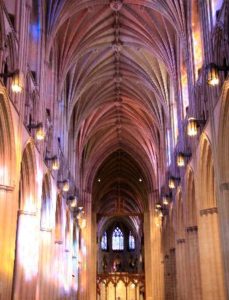With classical music under siege, many are rethinking audiences and venues. Here in Manhattan, Geffen Hall – previously Fisher Hall, and before that Philharmonic Hall – has never been an inviting place in which to hear music. The acoustics are defective, the ambience is nothing special. One cannot blame the hall for the New York Philharmonic’s disengaged audience – but it’s a factor. At Carnegie Hall, ten blocks downtown, a community of listeners is joined on special occasions by distinguished ghosts seduced by echoes of a hallowed past.
PostClassical Ensemble – the DC chamber orchestra I co-founded 14 years ago – has at all times been without a special home, even an adequate home. Our concerts are thematic and sui generis. We incorporate film, dance, or theater. We don’t fit comfortably in a concert hall.
Last season PCE was invited by the Washington National Cathedral to produce “The Trumpet Shall Sound” – a concert intermingling spirituals and religious arias, all sung by the inspirational bass-baritone Kevin Deas. The Cathedral Choir – a superb professional chorus – took part, as did dozens of DC high school choristers. The main nave – a towering, aspirant spiritual corridor — was full. The audience was inter-racial. The music impacted in ways no concert hall could possibly have fostered.
PCE was subsequently invited by Mike McCarthy, the Cathedral’s music director, to become an Ensemble-in-Residence. Mike is a man with a mission and it aligns with ours: to explore music as an instrument for human betterment. Addressing PCE’s new residency, he commented:
“Washington National Cathedral is one of the finest examples of devotional art in the world. It stands testament to mankind’s yearning to see the perfection of beauty on earth. It allows us to glimpse a portal through which we can experience the divine. In such an environment music plays a crucial role, amplified by inspirational surroundings. It is both a cultural legacy that we have inherited and cherish, and a means for responding to the world and its challenges.”
Our initial season of concerts at the National Cathedral comprises “Music in Wartime,” a Pearl Harbor Day commemoration; “Deep River – The Art of the Spiritual,” a Harry Burleigh celebration; and “Secret Skirmishes of the Cold War: The Shostakovich Case,” a reconsideration of the CIA’s cultural Cold War.
The first of these events will begin with one of Hanns Eisler’s workers’ songs performed as a processional. The second will end with “Goin’ Home” as a spacial experience. The third will include an actor performing as John F. Kennedy. For 2018-19 we are planning a mega-event which will empty the nave of pews and incorporate lighting design. The Cathedral also offers a multitude of smaller spaces ideal for art installations, and for lectures and discussion.
At a national moment when art for art’s sake seems increasingly irrelevant, the Washington National Cathedral seems newly pertinent to art.


Leave a Reply